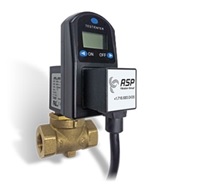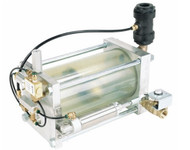Unveiling the Science Behind Air Compressor Drain …
Posted by AVP on Jun 6th 2023
Behind the seemingly simple task of releasing excess water lies a fascinating science! Join me as we delve into the intricate workings of air compressor drain valves.
From the physics behind water separation to the mechanics of valve design, we'll unravel the secrets that make these unassuming components vital in maintaining optimal air compressor performance.
If you've ever wondered how air compressor drain valves work and why they are crucial, this blog is for you.
Why You Need a Drain Valve
Air compressor drain valves play a crucial role in maintaining the efficiency and longevity of air compressors. These valves are responsible for removing the accumulated water or condensate that builds up within the compressor system.
While it may seem like a simple task, the science behind these valves is quite intriguing and warrants closer examination.
Physics of Water Separation
To understand the science behind air compressor drain valves, we must first grasp the concept of condensation within air compressors. As air undergoes compression, its temperature surges, leading to the delightful phenomenon of moisture condensation.
This condensate, a mixture of water and oil, accumulates within the compressor system and poses a threat to its performance and reliability.
This is where air compressor drain valves come into play. These valves provide an efficient solution for removing unwanted condensate from the system, preventing damage, and ensuring optimal operation.
By understanding the physics of water separation, we can appreciate the significance of these valves.
Mechanics of Air Compressor Drain Valves
Air compressor drain valves come in various types, each with its own unique mechanism for removing condensate. One popular type is the solenoid electric drain valve, which offers convenience and efficiency.
Let's explore the mechanics of solenoid electric drain valves in more detail.

Solenoid Electric Drain Valves - Effortlessly Bidding Farewell to Condensate
Solenoid electric drain valves, such as the pocket-friendly EDV Solenoid drain valve, are designed to simplify the draining process in air compressor systems. These valves incorporate an integrated strainer, effectively tackling potential clogs and ensuring uninterrupted condensate removal.
Features and Benefits
The EDV Series drain valves boast several features that make them an ideal choice for condensate management. The adjustable valve open and cycle times allow users to customize the draining process according to their specific needs.
With adjustable settings ranging from 1 to 60 seconds for valve open time and 1 to 60 minutes for cycle time, these valves provide flexibility and adaptability to varying operating conditions.
How They Eliminate Condensate
The solenoid electric drain valves operate by using an electric signal to open and close the valve. When the predetermined cycle time is reached, the valve opens, allowing the condensate to be discharged.
Once the cycle is complete, the valve closes, preventing any air leakage or unnecessary loss of compressed air.
Time-Saving Functionality Meets Customizable Convenience
One of the major advantages of solenoid electric drain valves is their ability to save time and effort. Manual draining can be a tedious and time-consuming task, requiring frequent monitoring and manual intervention.
With the EDV Series drain valves, the draining process becomes automatic, eliminating the need for constant manual attention and freeing up valuable time for other important tasks.
Installation and Maintenance of Drain Valves
Installing an air compressor drain valve is a relatively simple process that can be accomplished with a few basic tools. Let's dive into a handy, step-by-step installation guide:
- Find the perfect spot for the drain valve in your air compressor system—aim for the lowest point possible.
- Shut down the air compressor and ensure that the system is depressurized.
- Locate the condensate drain port and remove any existing plugs or fittings.
- Attach the drain valve securely to the condensate drain port, making sure it is properly sealed to prevent any air or water leakage.
- Connect the drain valve to a suitable outlet for discharging the condensate, such as a drain pipe or container.
- Double-check all connections and ensure that the valve is properly aligned and secured.
- Turn on the air compressor and test the functionality of the drain valve to ensure proper operation.
Proper maintenance of air compressor drain valves is essential for their continued effectiveness.
Regular inspections and cleaning can help prevent clogs and ensure optimal performance.
Refer to the manufacturer's guidelines for specific maintenance recommendations and frequency.
Common Questions about Air Compressor Drain Valves
FAQ 1: Can a malfunctioning drain valve cause damage to the air compressor?
Yes, a malfunctioning drain valve can lead to serious damage to the air compressor. If the condensate is not effectively removed from the system, it can mix with the lubricating oil, causing contamination and potentially leading to component failure.
Regular maintenance and inspection of drain valves are crucial to avoid such issues.
FAQ 2: How do you install a drain valve?
Installing a drain valve requires identifying a suitable location at the lowest point in the air compressor system, shutting down the compressor, depressurizing the system, removing any existing plugs or fittings, securely attaching the drain valve to the condensate drain port, connecting it to a discharge outlet, and testing its functionality.
FAQ 3: How often should drain valves be inspected and cleaned?
The frequency of inspections and cleaning depends on various factors such as the operating conditions, compressor usage, and the level of condensate accumulation.
However, regular inspection and cleaning of drain valves are highly recommended to maintain their peak performance. Including this task as part of routine maintenance ensures that these valves function optimally and prevent any potential issues down the line.
FAQ 4: Can drain valves be retrofitted to existing air compressor systems?
Yes, drain valves can often be retrofitted to existing air compressor systems. However, it is essential to ensure compatibility and proper installation to avoid any potential issues.
Consulting with a professional or referring to the manufacturer's guidelines is recommended when retrofitting drain valves.
FAQ 5: Are there any alternatives to drain valves for condensate removal?
While drain valves are the most common and effective method for condensate removal, there are alternative options available, such as manual drain ports or automatic condensate management systems such as the RD11-VAC, Zero-loss Pneumatic Condensate Robo-Drain Valve.
Buy Air Compressor Drain Valves Here at AVP
Air compressor drain valves are essential components that ensure the efficient removal of condensate from compressor systems. Understanding the science behind these valves helps us appreciate their significance in maintaining optimal performance and reliability.
Whether it's the physics of water separation or the mechanics of solenoid electric drain valves, each aspect contributes to the overall functionality of these vital components.
Next time you hear the subtle hiss of an air compressor drain valve releasing excess water, remember the fascinating science that lies beneath the surface. Explore different valve options, such as Solenoid Electric Drain Valves (EDV), to find the perfect fit for your air compressor system.
